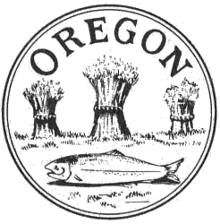Oregon pioneer history
The period begins after the explorations of the lower Columbia River by Robert Gray and George Vancouver in 1792, along with the 1804–1806 Lewis and Clark Expedition to Oregon Country, and runs until circa 1890 when railroads and urban centers created a more settled state.
At the beginning of the pioneer period the Oregon Country was the homeland of numerous tribes of Native Americans.
In 1818, the United States and Great Britain signed the Treaty of 1818 that led to what has been termed a "joint occupation" of the Oregon Country.
[1] However, due to some ambiguity in the treaty, future conflict did arise and ended with the bloodless Pig War over the San Juan Islands.
The portion that became part of the United States in 1846 remained unorganized until Congress created the Oregon Territory in August 1848.
[3] Beginning in 1841 with the death of Ewing Young, settlers in the Willamette Valley held a series of meetings at Champoeg, Oregon.
[2] Eventually, in 1843 the majority of participants voted to create a government to rule over the pioneers until the boundary question would be settled.
[3] In 1857, the people of the territory passed a resolution to hold a convention to draft a constitution in order to achieve statehood.
[4] The first Americans to return were members of John Jacob Astor's Pacific Fur Company as part of an expedition that established Fort Astoria at the mouth of the Columbia River in 1811.
When Astor tried to regain the post, the British insisted their takeover was a business deal, not an act of war.
[4] Later the HBC would start the Puget Sound Agricultural Company to supply food staples to the venture.
This policy, although successful in making beaver rare in the Willamette Valley, did not prevent American settlement.
The next player in the fur trade was American Nathaniel Jarvis Wyeth who had made a fortune in the ice business in New England.
[9] Then in 1849 the United States Army arrived after the creation of the Oregon Territory and set up adjacent to Fort Vancouver.
By the 1830s a steady stream of travelers entered Oregon from the south through California and from the east over the Rocky Mountains.
The settlers were led by American Ewing Young, with others such as Jason Lee of the Methodist Mission and John McLoughlin of the Hudson's Bay Company providing additional investment.
Young led a small group to California, sailing from the Willamette River to San Francisco Bay.

